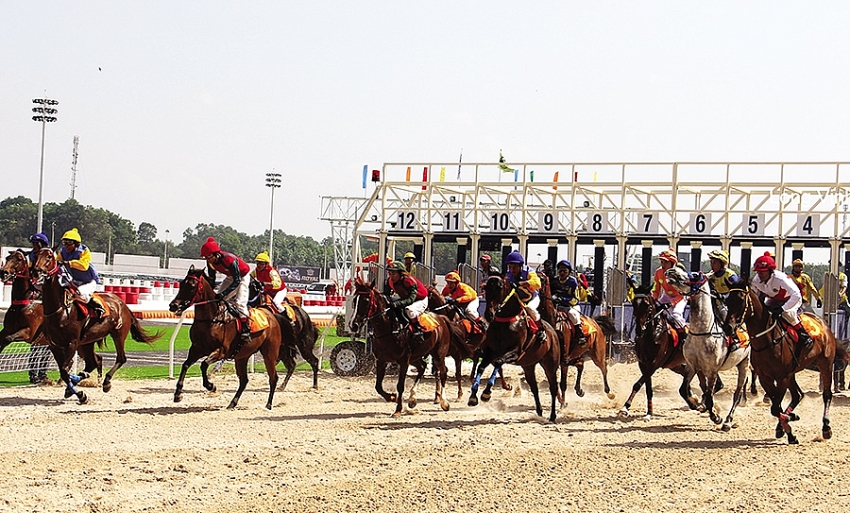
G.O.Max I&D and Hanoitourists are both seeking to build horse racecourses very close to each other. (Photo: Le Toan)
G.O.Max I&D expressed its concern regarding another proposal to develop a $420 million large-scale horse racecourse in Hanoi – the neighbouring city of its own racetrack in Vinh Phuc.
According to Hong Nam Pyo, CEO and chairman of G.O.Max I&D, the Hanoi project is very near to his project.
“I am very confused about how we [the investors of the two projects] can do our projects as they are so close to each other. The government cannot give licences to too many projects in Vietnam because it is not feasible,” Pyo told VIR in an interview.
Comparing the two projects, the benefits that they are expected to bring their respective localities are both huge, according to the investors.
G.O.Max I&D’s project includes a 72-hole golf course, a sports and entertainment complex, a horse riding and polo club, as well as apartments and villas built on a land area of 750 hectares. G.O.Max I&D expects to acquire $972 million in annual revenue in the first years of operation and would contribute $100 million to the state budget per year.
The Hanoitourist and GCN-proposed racetrack in Hanoi, meanwhile, will cover an area of 125ha, including a 30,000-seat horse racecourse. This project was first tabled in 1999. It was initially planned to be built in Hoang Mai and Thanh Tri, two outskirt districts of Hanoi. However, as the legal framework for sports betting and horse racing had not been completed yet, the foreign partner withdrew from the project in 2005.
In 2007, Hanoitourist and GCN proposed the project once again, but they moved the project site to Soc Son – another outskirt district of Hanoi where the project would mostly be built on agricultural land. However, this project proposal could not be approved because the legal framework was not finished yet.
It was not until August 2016 that the two sides once again inked a joint venture contract to invest in this project, a few months before the government issued Decree No.06/2017/ND-CP – the official legal framework on betting business on horse racing, dog racing, and international betting in Vietnam.
Most recently, in December 2018, the prime minister approved Hanoi’s adjusted plan on socio-economic development until 2020, with vision to 2030. Accordingly, the multifunctional complex in Hanoi including a horse racecourse was added to the list of projects prioritised for development. According to the investors, this track will contribute VND1-1.5 trillion ($43.5-65.2 million) per year to the city’s state budget.
Even as Hanoitourist’s racecourse was approved, G.O.Max I&C is still massively enthusiastic about the project.
“We first proposed the project in 2004, a long time ago, and we have been doing our best to support the Vietnamese government in setting up guidelines and policies on sports betting and especially horse betting during the past years,” Pyo said. “We have met all requirements of the government and local authorities. We are still committed to this project and hope to receive the decision from the government as soon as possible, since we have invested a great deal of time and money into the feasibility study of this project.”
Moreover, Pyo also expressed concerns about the Vietnamese government’s mechanism to deal with too many proposals of horse racecourses in Vietnam.
So far, only the Dai Nam horse racecourse has been put into operation in 2017. Apart from the Vinh Phuc and Soc Son proposals, many others have been proposed to be built in cities and provinces of Bac Ninh, Phu Yen, Ba Ria-Vung Tau, Danang, and Can Tho.
According to Pyo, the government should consider which project could be the most efficient. “As a horse racecourse is not only for betting, it must contribute to the development of sports and other related services and industries, like horse breeding and training,” he added.
Commenting on this issue, Ha Ton Vinh, who has spent much of his professional life studying casino and sports betting activities in Vietnam, told VIR that having numerous investors proposing to develop horse racecourses in different cities and provinces was better than having only a few proposals.
“Many proposals means greater choice for the government, which can pick the most feasible projects,” Vinh said.
“In the particular case of the racecourses in Hanoi and Vinh Phuc, I know that the investors proposed these projects a long time ago, and it is obviously not feasible for the government to approve both of them, and the investors also refuse this decision. The government will have to consider this incident and the investors need to prove the feasibility of their projects to convince the government,” he added.

















